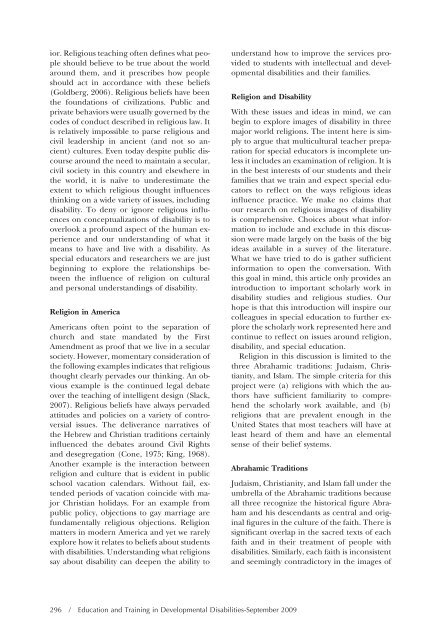Education and Training in Developmental Disabilities - Division on ...
Education and Training in Developmental Disabilities - Division on ...
Education and Training in Developmental Disabilities - Division on ...
You also want an ePaper? Increase the reach of your titles
YUMPU automatically turns print PDFs into web optimized ePapers that Google loves.
ior. Religious teach<str<strong>on</strong>g>in</str<strong>on</strong>g>g often def<str<strong>on</strong>g>in</str<strong>on</strong>g>es what people<br />
should believe to be true about the world<br />
around them, <str<strong>on</strong>g>and</str<strong>on</strong>g> it prescribes how people<br />
should act <str<strong>on</strong>g>in</str<strong>on</strong>g> accordance with these beliefs<br />
(Goldberg, 2006). Religious beliefs have been<br />
the foundati<strong>on</strong>s of civilizati<strong>on</strong>s. Public <str<strong>on</strong>g>and</str<strong>on</strong>g><br />
private behaviors were usually governed by the<br />
codes of c<strong>on</strong>duct described <str<strong>on</strong>g>in</str<strong>on</strong>g> religious law. It<br />
is relatively impossible to parse religious <str<strong>on</strong>g>and</str<strong>on</strong>g><br />
civil leadership <str<strong>on</strong>g>in</str<strong>on</strong>g> ancient (<str<strong>on</strong>g>and</str<strong>on</strong>g> not so ancient)<br />
cultures. Even today despite public discourse<br />
around the need to ma<str<strong>on</strong>g>in</str<strong>on</strong>g>ta<str<strong>on</strong>g>in</str<strong>on</strong>g> a secular,<br />
civil society <str<strong>on</strong>g>in</str<strong>on</strong>g> this country <str<strong>on</strong>g>and</str<strong>on</strong>g> elsewhere <str<strong>on</strong>g>in</str<strong>on</strong>g><br />
the world, it is naïve to underestimate the<br />
extent to which religious thought <str<strong>on</strong>g>in</str<strong>on</strong>g>fluences<br />
th<str<strong>on</strong>g>in</str<strong>on</strong>g>k<str<strong>on</strong>g>in</str<strong>on</strong>g>g <strong>on</strong> a wide variety of issues, <str<strong>on</strong>g>in</str<strong>on</strong>g>clud<str<strong>on</strong>g>in</str<strong>on</strong>g>g<br />
disability. To deny or ignore religious <str<strong>on</strong>g>in</str<strong>on</strong>g>fluences<br />
<strong>on</strong> c<strong>on</strong>ceptualizati<strong>on</strong>s of disability is to<br />
overlook a profound aspect of the human experience<br />
<str<strong>on</strong>g>and</str<strong>on</strong>g> our underst<str<strong>on</strong>g>and</str<strong>on</strong>g><str<strong>on</strong>g>in</str<strong>on</strong>g>g of what it<br />
means to have <str<strong>on</strong>g>and</str<strong>on</strong>g> live with a disability. As<br />
special educators <str<strong>on</strong>g>and</str<strong>on</strong>g> researchers we are just<br />
beg<str<strong>on</strong>g>in</str<strong>on</strong>g>n<str<strong>on</strong>g>in</str<strong>on</strong>g>g to explore the relati<strong>on</strong>ships between<br />
the <str<strong>on</strong>g>in</str<strong>on</strong>g>fluence of religi<strong>on</strong> <strong>on</strong> cultural<br />
<str<strong>on</strong>g>and</str<strong>on</strong>g> pers<strong>on</strong>al underst<str<strong>on</strong>g>and</str<strong>on</strong>g><str<strong>on</strong>g>in</str<strong>on</strong>g>gs of disability.<br />
Religi<strong>on</strong> <str<strong>on</strong>g>in</str<strong>on</strong>g> America<br />
Americans often po<str<strong>on</strong>g>in</str<strong>on</strong>g>t to the separati<strong>on</strong> of<br />
church <str<strong>on</strong>g>and</str<strong>on</strong>g> state m<str<strong>on</strong>g>and</str<strong>on</strong>g>ated by the First<br />
Amendment as proof that we live <str<strong>on</strong>g>in</str<strong>on</strong>g> a secular<br />
society. However, momentary c<strong>on</strong>siderati<strong>on</strong> of<br />
the follow<str<strong>on</strong>g>in</str<strong>on</strong>g>g examples <str<strong>on</strong>g>in</str<strong>on</strong>g>dicates that religious<br />
thought clearly pervades our th<str<strong>on</strong>g>in</str<strong>on</strong>g>k<str<strong>on</strong>g>in</str<strong>on</strong>g>g. An obvious<br />
example is the c<strong>on</strong>t<str<strong>on</strong>g>in</str<strong>on</strong>g>ued legal debate<br />
over the teach<str<strong>on</strong>g>in</str<strong>on</strong>g>g of <str<strong>on</strong>g>in</str<strong>on</strong>g>telligent design (Slack,<br />
2007). Religious beliefs have always pervaded<br />
attitudes <str<strong>on</strong>g>and</str<strong>on</strong>g> policies <strong>on</strong> a variety of c<strong>on</strong>troversial<br />
issues. The deliverance narratives of<br />
the Hebrew <str<strong>on</strong>g>and</str<strong>on</strong>g> Christian traditi<strong>on</strong>s certa<str<strong>on</strong>g>in</str<strong>on</strong>g>ly<br />
<str<strong>on</strong>g>in</str<strong>on</strong>g>fluenced the debates around Civil Rights<br />
<str<strong>on</strong>g>and</str<strong>on</strong>g> desegregati<strong>on</strong> (C<strong>on</strong>e, 1975; K<str<strong>on</strong>g>in</str<strong>on</strong>g>g, 1968).<br />
Another example is the <str<strong>on</strong>g>in</str<strong>on</strong>g>teracti<strong>on</strong> between<br />
religi<strong>on</strong> <str<strong>on</strong>g>and</str<strong>on</strong>g> culture that is evident <str<strong>on</strong>g>in</str<strong>on</strong>g> public<br />
school vacati<strong>on</strong> calendars. Without fail, extended<br />
periods of vacati<strong>on</strong> co<str<strong>on</strong>g>in</str<strong>on</strong>g>cide with major<br />
Christian holidays. For an example from<br />
public policy, objecti<strong>on</strong>s to gay marriage are<br />
fundamentally religious objecti<strong>on</strong>s. Religi<strong>on</strong><br />
matters <str<strong>on</strong>g>in</str<strong>on</strong>g> modern America <str<strong>on</strong>g>and</str<strong>on</strong>g> yet we rarely<br />
explore how it relates to beliefs about students<br />
with disabilities. Underst<str<strong>on</strong>g>and</str<strong>on</strong>g><str<strong>on</strong>g>in</str<strong>on</strong>g>g what religi<strong>on</strong>s<br />
say about disability can deepen the ability to<br />
underst<str<strong>on</strong>g>and</str<strong>on</strong>g> how to improve the services provided<br />
to students with <str<strong>on</strong>g>in</str<strong>on</strong>g>tellectual <str<strong>on</strong>g>and</str<strong>on</strong>g> developmental<br />
disabilities <str<strong>on</strong>g>and</str<strong>on</strong>g> their families.<br />
Religi<strong>on</strong> <str<strong>on</strong>g>and</str<strong>on</strong>g> Disability<br />
With these issues <str<strong>on</strong>g>and</str<strong>on</strong>g> ideas <str<strong>on</strong>g>in</str<strong>on</strong>g> m<str<strong>on</strong>g>in</str<strong>on</strong>g>d, we can<br />
beg<str<strong>on</strong>g>in</str<strong>on</strong>g> to explore images of disability <str<strong>on</strong>g>in</str<strong>on</strong>g> three<br />
major world religi<strong>on</strong>s. The <str<strong>on</strong>g>in</str<strong>on</strong>g>tent here is simply<br />
to argue that multicultural teacher preparati<strong>on</strong><br />
for special educators is <str<strong>on</strong>g>in</str<strong>on</strong>g>complete unless<br />
it <str<strong>on</strong>g>in</str<strong>on</strong>g>cludes an exam<str<strong>on</strong>g>in</str<strong>on</strong>g>ati<strong>on</strong> of religi<strong>on</strong>. It is<br />
<str<strong>on</strong>g>in</str<strong>on</strong>g> the best <str<strong>on</strong>g>in</str<strong>on</strong>g>terests of our students <str<strong>on</strong>g>and</str<strong>on</strong>g> their<br />
families that we tra<str<strong>on</strong>g>in</str<strong>on</strong>g> <str<strong>on</strong>g>and</str<strong>on</strong>g> expect special educators<br />
to reflect <strong>on</strong> the ways religious ideas<br />
<str<strong>on</strong>g>in</str<strong>on</strong>g>fluence practice. We make no claims that<br />
our research <strong>on</strong> religious images of disability<br />
is comprehensive. Choices about what <str<strong>on</strong>g>in</str<strong>on</strong>g>formati<strong>on</strong><br />
to <str<strong>on</strong>g>in</str<strong>on</strong>g>clude <str<strong>on</strong>g>and</str<strong>on</strong>g> exclude <str<strong>on</strong>g>in</str<strong>on</strong>g> this discussi<strong>on</strong><br />
were made largely <strong>on</strong> the basis of the big<br />
ideas available <str<strong>on</strong>g>in</str<strong>on</strong>g> a survey of the literature.<br />
What we have tried to do is gather sufficient<br />
<str<strong>on</strong>g>in</str<strong>on</strong>g>formati<strong>on</strong> to open the c<strong>on</strong>versati<strong>on</strong>. With<br />
this goal <str<strong>on</strong>g>in</str<strong>on</strong>g> m<str<strong>on</strong>g>in</str<strong>on</strong>g>d, this article <strong>on</strong>ly provides an<br />
<str<strong>on</strong>g>in</str<strong>on</strong>g>troducti<strong>on</strong> to important scholarly work <str<strong>on</strong>g>in</str<strong>on</strong>g><br />
disability studies <str<strong>on</strong>g>and</str<strong>on</strong>g> religious studies. Our<br />
hope is that this <str<strong>on</strong>g>in</str<strong>on</strong>g>troducti<strong>on</strong> will <str<strong>on</strong>g>in</str<strong>on</strong>g>spire our<br />
colleagues <str<strong>on</strong>g>in</str<strong>on</strong>g> special educati<strong>on</strong> to further explore<br />
the scholarly work represented here <str<strong>on</strong>g>and</str<strong>on</strong>g><br />
c<strong>on</strong>t<str<strong>on</strong>g>in</str<strong>on</strong>g>ue to reflect <strong>on</strong> issues around religi<strong>on</strong>,<br />
disability, <str<strong>on</strong>g>and</str<strong>on</strong>g> special educati<strong>on</strong>.<br />
Religi<strong>on</strong> <str<strong>on</strong>g>in</str<strong>on</strong>g> this discussi<strong>on</strong> is limited to the<br />
three Abrahamic traditi<strong>on</strong>s: Judaism, Christianity,<br />
<str<strong>on</strong>g>and</str<strong>on</strong>g> Islam. The simple criteria for this<br />
project were (a) religi<strong>on</strong>s with which the authors<br />
have sufficient familiarity to comprehend<br />
the scholarly work available, <str<strong>on</strong>g>and</str<strong>on</strong>g> (b)<br />
religi<strong>on</strong>s that are prevalent enough <str<strong>on</strong>g>in</str<strong>on</strong>g> the<br />
United States that most teachers will have at<br />
least heard of them <str<strong>on</strong>g>and</str<strong>on</strong>g> have an elemental<br />
sense of their belief systems.<br />
Abrahamic Traditi<strong>on</strong>s<br />
296 / <str<strong>on</strong>g>Educati<strong>on</strong></str<strong>on</strong>g> <str<strong>on</strong>g>and</str<strong>on</strong>g> <str<strong>on</strong>g>Tra<str<strong>on</strong>g>in</str<strong>on</strong>g><str<strong>on</strong>g>in</str<strong>on</strong>g>g</str<strong>on</strong>g> <str<strong>on</strong>g>in</str<strong>on</strong>g> <str<strong>on</strong>g>Developmental</str<strong>on</strong>g> <str<strong>on</strong>g>Disabilities</str<strong>on</strong>g>-September 2009<br />
Judaism, Christianity, <str<strong>on</strong>g>and</str<strong>on</strong>g> Islam fall under the<br />
umbrella of the Abrahamic traditi<strong>on</strong>s because<br />
all three recognize the historical figure Abraham<br />
<str<strong>on</strong>g>and</str<strong>on</strong>g> his descendants as central <str<strong>on</strong>g>and</str<strong>on</strong>g> orig<str<strong>on</strong>g>in</str<strong>on</strong>g>al<br />
figures <str<strong>on</strong>g>in</str<strong>on</strong>g> the culture of the faith. There is<br />
significant overlap <str<strong>on</strong>g>in</str<strong>on</strong>g> the sacred texts of each<br />
faith <str<strong>on</strong>g>and</str<strong>on</strong>g> <str<strong>on</strong>g>in</str<strong>on</strong>g> their treatment of people with<br />
disabilities. Similarly, each faith is <str<strong>on</strong>g>in</str<strong>on</strong>g>c<strong>on</strong>sistent<br />
<str<strong>on</strong>g>and</str<strong>on</strong>g> seem<str<strong>on</strong>g>in</str<strong>on</strong>g>gly c<strong>on</strong>tradictory <str<strong>on</strong>g>in</str<strong>on</strong>g> the images of

















